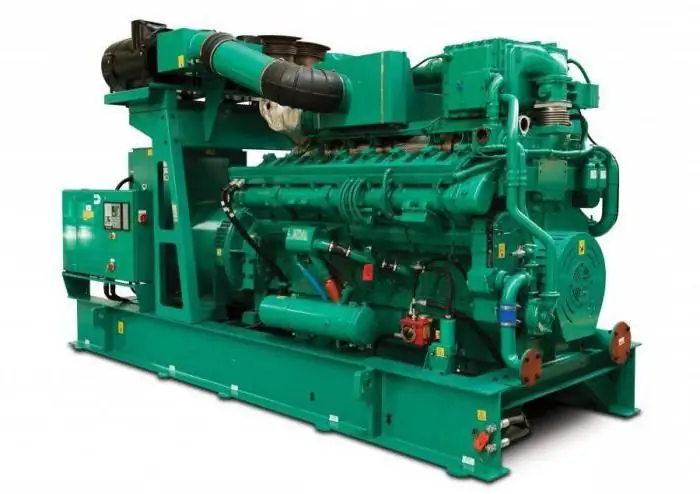2026 Author: Howard Calhoun | [email protected]. Last modified: 2025-01-24 13:10:41
The whole history of mankind is literally permeated with the struggle with nature for minerals. And such a confrontation is not accidental, since absolutely any branch of our life activity is energy-intensive. Therefore, in such a situation, it seems quite logical that we are striving in every possible way to find alternative sources of cheap, renewable energy. In this regard, it is worth paying close attention to the Kislogubskaya TPP.
Just the facts
Speaking about this station, it should immediately be noted that it stands apart in the "family" of power plants in the Russian Federation. The construction of the Kislogubskaya TPP was initially experimental, and it must be said that it turned out to be quite successful.

At its core, this industrial facility is a station operating by using the energy of the sea tides, that is, in principle, the kinetic energy released during the rotation of our planet. This man-made source of cheap electricity has been registered by the state as a monument to technology and science.
Construction and commissioning
In 1968, the InstituteHydroproject. The leader of this event was the chief engineer of the institution, L. B. Bernshtein. The construction of the station was carried out in the most progressive way for that time, which consisted in the creation of a reinforced concrete building in a dock near Murmansk, followed by towing the resulting structure to its place of work on the surface of the sea. One water conduit of the station had a French-made capsule hydraulic apparatus (its capacity was 0.4 MW), and the second, in which it was planned to install a domestic hydroelectric unit, was left empty. After the start-up, the power plant was put on the balance sheet of Kolenergo. It was used as an experimental base. Leading specialists in the field of construction were involved in the construction of the station, because an additional difficulty was the landscape and climate of the place where the TPP was eventually built.

Dislocation location
Kislogubskaya TPP was built on the coast of the Barents Sea, and more specifically, in a bay called Kislaya, where the height of the tides may well reach five meters. By the way, on the Kola Peninsula, the so-called “lips” are rather narrow bays that penetrate deep into the land. It is this place that is the most ideal in terms of the construction of tidal station dams.
Working principle
PES works, at first glance, in an elementary way: at the moment of high tide, the water rises up and enters the upper pool, forcing the turbine to rotate. When the tide begins to ebb, the water, retreating back into the sea, again leads toturbine movement. This is how electrical energy is generated. The whole secret lies in the nuances that only highly specialized specialists can tell about.

Downtime period
The only tidal power plant in Russia operated until 1992. However, at that time the country's economy was going through far better times, and the further development of this type of electricity production had to be forgotten. PES was stopped and mothballed. The remoteness from transport interchanges and settlements saved the station from plunder by vandals and elementary physical destruction, plus, the responsibility and dedication of the remaining personnel also helped the station to continue its existence.
A new round of life
It is safe to say that the Kislogubskaya TPP was lucky, because in 2004 it started its work again, for which we should thank Anatoly Chubais, who paid close attention to the continuous development of tidal energy.
The already obsolete both morally and physically hydraulic unit was immediately dismantled. In its place, a new analogue was put, having an orthogonal design.
2007 was marked by the construction of a new unit with a turbine capacity of 1.5 MW. This block was transported by sea and connected to the old building. As a result, the station received a modern appearance. At the end of 2006, the station was connected to a power line with a voltage of 35 kV.
Belongs toPES to RusHydro Open Joint Stock Company.
Additional information
The described tidal power plant in Russia is also where they are experimenting with the production of electricity from natural sources. So, on the territory of this facility there are solar panels that are involved in the accumulation of solar energy with its subsequent transformation into electricity. There is also a wind measuring complex at the station, which in its appearance resembles a cell tower, which, by the way, is not here at all. The task of the complex is to collect information regarding the direction and strength of the wind. This is done with the aim of developing alternative energy.

In general, you can get to the PES (Murmansk region) only by sea. The staff here is small - only 10 people who work on a rotational basis for fifteen days. It is also important to note the fact that the variety of fish caught in the area of the station is very high. And therefore we can conclude: PES does not cause any damage to the environment.
Technical capabilities of the station
Kislogubskaya TPP (on the map below, it is quite easy to find it) has a rather small total capacity - 1.7 MW. Stable, uninterrupted operation of the facility can provide electricity to a village with a population of 5,000 people.

Living conditions
Where the Kislogubskaya PES is located, there was also a place for a residential building for workersstation, warehouse, garage, water main (water comes from a mountain lake). In addition, the territory of the industrial facility has given shelter to the scientific base of the Polar Research Institute of Marine Fisheries and Oceanography. Knipovich.
Analysis of station operation
Forty-five years of research on TPP has confirmed that its operation ensures its reliable operation in the power system, both at peak and standard load times. The unique Russian-made variable speed generator used at the station made it possible to increase the efficiency of the station by 5%.
The reinforced concrete structure of the TPP building is thin-walled, but even after forty-five years of extreme operation, it has remained in good condition. The most important achievement can be considered the prevention of corrosion of metal surfaces of structures and equipment. The concrete of the building is ideal in terms of frost resistance. No damage was found on its surface. The strength was higher than the design value.

Summing up, it can be noted that the Murmansk region has become a real cradle for the birth and development of tidal energy, which in itself is an industry of the future, because extracting electricity in this way is absolutely safe for humans and nature, as well as the most profitable and justified with economic point of view. In this regard, the planned construction of several moretidal power plants throughout the country.
Recommended:
Nuclear power plants. Nuclear power plants of Ukraine. Nuclear power plants in Russia

Modern energy needs of mankind are growing at a gigantic pace. Its consumption for lighting cities, for industrial and other needs of the national economy is increasing. Accordingly, more and more soot from burning coal and fuel oil is emitted into the atmosphere, and the greenhouse effect increases. In addition, there has been more and more talk in recent years about the introduction of electric vehicles, which will also contribute to the increase in electricity consumption
What is reactive power? Reactive power compensation. Reactive power calculation

In real production conditions, reactive power of an inductive nature prevails. The enterprises install not one electric meter, but two, one of which is active. And for the overexpenditure of energy “chased” in vain through power lines, the relevant authorities are mercilessly fined
Gas piston power plant: the principle of operation. Operation and maintenance of gas piston power plants

Gas piston power plant is used as a main or backup source of energy. The device requires access to any type of combustible gas to operate. Many GPES models can additionally generate heat for heating and cold for ventilation systems, warehouses, industrial facilities
Floating nuclear power plant "Akademik Lomonosov". Floating nuclear power plant "Northern Lights"

A new word in the use of peaceful atom - a floating nuclear power plant - innovations of Russian designers. In the world today, such projects are the most promising for providing electricity to settlements for which local resources are not enough. And these are offshore developments in the Arctic, and the Far East, and Crimea. The floating nuclear power plant, which is being built at the B altic Shipyard, is already attracting great interest from domestic and foreign investors
Gas turbine power plants. Mobile gas turbine power plant

For the functioning of industrial and economic facilities located at a considerable distance from the centralized power lines, small-scale power generating installations are used. They can operate on various types of fuel. Gas turbine power plants are most widely used due to their high efficiency, ability to generate thermal energy and a number of other features

